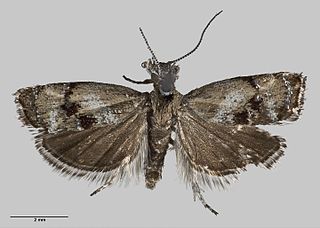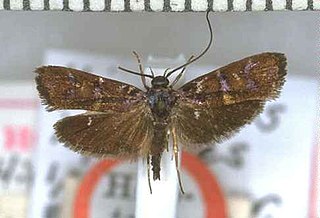Diastaltica is a genus of moths in the family Gelechiidae. It contains the species Diastaltica separabilis, which is found in Guatemala.
Perioristica is a genus of moth in the family Gelechiidae. It contains the species Perioristica chalcopera, which is found in Mexico (Guerrero).

Plusia festucae is a species of moth of the family Noctuidae. It is found throughout the Palearctic realm from Ireland to Japan.

Elachista apicipunctella is a moth of the family Elachistidae found in Europe. It is found in all of Europe, east into northern Russia.

Stigmella tityrella is a species of moth in the family Nepticulidae. It is found in all of Europe west of Russia.

Asterivora urbana is a species of moth in the family Choreutidae. It is endemic to New Zealand and has been observed in Arthur's Pass. Adults are on the wing in January.

Glyphipterix forsterella is a moth of the family Glyphipterigidae. It is found from most of Europe, east to Japan.

Hierodoris iophanes is a moth of the family Oecophoridae. It was described by Edward Meyrick in 1912. This species can be distinguished from others in its genus by the purple metallic colouration as well as the blue-white mark on its forewings. It is endemic to New Zealand, where it has been recorded from Auckland to Southland. This species inhabits native forest or scrub, with the adults preferring open glades. They are known to be on the wing from November until February and fly during daylight hours, being active on hot sunny days. Larvae feed on the interior of twigs of Prumnopitys ferruginea. The twigs had evidence of oviposition scars of cicadas and the larvae were collected in October after reddish-brown frass indicated their location within the twigs.
Ambia fulvicolor is a moth in the family Crambidae. It was described by George Hampson in 1917 and it is found in New Guinea.
Helcystogramma gypsaspis is a moth in the family Gelechiidae. It was described by Edward Meyrick in 1921. It is found on Java in Indonesia.
Onebala amethystina is a moth in the family Gelechiidae. It was described by Edward Meyrick in 1904. It is found in Australia, where it has been recorded from New South Wales and Queensland.
Calliprora clistogramma is a moth of the family Gelechiidae. It is found in Brazil.
Compsolechia argyracma is a moth of the family Gelechiidae. It was described by Edward Meyrick in 1922. It is found in Pará, Brazil.
Holophysis xanthostoma is a moth of the family Gelechiidae. It was described by Walsingham in 1910. It is found in Mexico (Guerrero).
Aristotelia argyractis is a moth of the family Gelechiidae, which are commonly known as gelechiid or twirler moths. It was described by Edward Meyrick in 1923 and is found in Amazonas, Brazil.
Polyhymno deuteraula is a moth of the family Gelechiidae. It was described by Edward Meyrick in 1914. It is found in Mozambique, Namibia and South Africa.
Polyhymno hostilis is a moth of the family Gelechiidae. It was described by Edward Meyrick in 1918. It is found in Namibia, Zimbabwe and the South African provinces of Gauteng, Mpumalanga and KwaZulu-Natal.
Polyhymno subaequalis is a moth of the family Gelechiidae. It was described by Walsingham in 1911. It is found in Mexico (Guerrero).
Idiocrates is a monotypic moth genus in the family Depressariidae. Its only species, Idiocrates balanitis, is found in Bolivia. Both the genus and species were first described by Edward Meyrick in 1909.
Psittacastis superatella is a moth in the family Depressariidae. It was described by Francis Walker in 1864. It is found in Brazil (Amazonas) and Peru.





